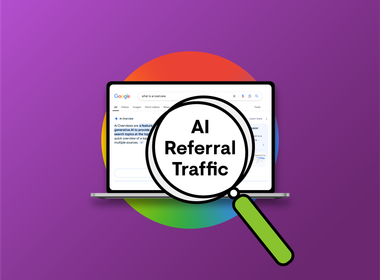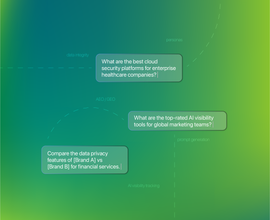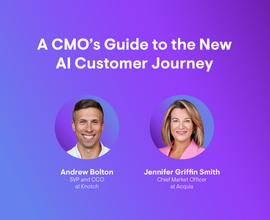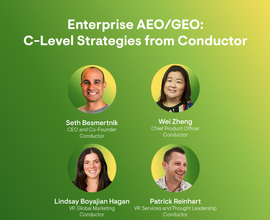What is AI Referral Traffic & How Do You Increase It?
For years, marketers have tracked referral traffic from sources like social media, partner websites, and organic search. Now, a new traffic source is emerging: AI. As millions of users turn to AI answer engines like ChatGPT and Perplexity for recommendations, these platforms are beginning to send visitors directly to websites. This new traffic channel, AI referral traffic, illustrates the shift in how users discover content.
What is AI referral traffic, and how do I increase it?
AI referral traffic is the audience segment that arrives on your website after clicking a link or citation within an AI-generated response.
Unlike traditional search traffic, where a user finds your site via a blue link, this traffic comes from users who have already received an answer directly from an AI. When they click through from a citation, it’s often because they want to dive deeper, verify a source, or take a specific action, signaling a much higher level of intent. This indicates that the traffic that comes from AI is further along in the funnel, signaling a higher level of interest.
What is the source of AI referral traffic?
This traffic originates from any AI platform that includes source links or citations in its answers. The most common sources today include:
- Google's AI Overviews: The citations that appear alongside Google's AI-generated summaries.
- Perplexity: This platform is built around providing cited answers and is a significant source of AI referrals.
- ChatGPT: When using its web-Browse capabilities, ChatGPT will often include links to the sources it used to generate its output.
As more AI tools integrate live web data, the number of potential referral sources will continue to grow.
Why should I care about AI referral traffic?
While still a growing channel, AI referral traffic is quickly becoming one of the most valuable sources for businesses. Because users arriving from an AI response have already had their initial query answered, their click-through demonstrates a strong desire to learn more or engage directly with the source. This results in highly qualified traffic that is often more likely to convert.
While it currently only accounts for a small percentage of the overall traffic on Conductor’s site, the conversion rates from an AI-referred visitor to free trial sign-up are 2x our best-performing channel (organic).
Although the volume of AI traffic isn’t as high as it was from traditional search, the volume is less important than the quality of the traffic. A small stream of this high-intent traffic can have an outsized impact on your business goals.
How is AI referral traffic measured?
Measuring AI referral traffic can be tricky, as it doesn't always show up neatly in analytics platforms. In Google Analytics 4 (GA4), for example, traffic from sources like ChatGPT or Perplexity will typically be categorized under the "Referral" channel. However, some AI-driven traffic can be miscategorized as "Direct," making precise measurement a challenge.
Platforms like Conductor can also offer insights into how AI views your content and website with our AI Search Performance and AI Topic Map features.
How to increase AI referral traffic
Increasing your share of AI referral traffic means creating a thorough strategy focused on becoming a citable, authoritative source.
- Become the primary source: Create comprehensive, well-structured, and factually accurate content that directly answers common user questions. The goal is to make your content the most reliable and direct answer available.
- Optimize for AI visibility: Invest in technical best practices that signal authority and trustworthiness to AI. This makes it easier for AI to understand what your content is about and trust its validity.
- Understand user intent on AI platforms: Recognize that users interact with AI differently than with traditional search. Use AI tools to understand the types of conversational questions and topics your audience is exploring on platforms like ChatGPT and Perplexity.
- Create and scale authoritative content: Once you understand the topics your audience is exploring via AI, create content that directly addresses those needs. As one expert notes, this is a key part of a successful strategy.
We're using our own AI tools to better understand what topics visitors use within ChatGPT and Perplexity, so we can better strategize what content we need to produce, and we use our own Content Creator to create that content at scale.
If you align your content strategy with the specific questions being asked on AI platforms, you’re much more likely to be used as a source in AI search and earn a referral link.
AI referral traffic represents the next evolution of organic marketing. While it may start as a small percentage of your overall traffic, its high quality and conversionConversion
Conversions are processes in online marketing that lead to a defined conclusion.
Learn more potential make it a channel that can’t be ignored. The brands that master this today will build a powerful, compounding advantage for the future.
FAQs
- What is AI search?
- What is AI visibility?
- How do I get my brand to show up in AI search?
- How do I measure AI search visibility for my brand?
- What are AI content guardrails?

![Dragos Bogdan, Senior Growth Product Manager, [object Object]](https://cdn.sanity.io/images/tkl0o0xu/production/c7dad9a9676412a48f8bae4ca375084dc52ed9a5-400x400.jpg?fit=min&w=100&h=100&dpr=1&q=95)






